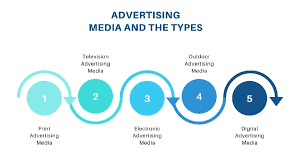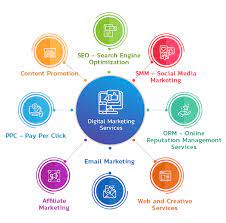Exploring Online Advertising Options
Online advertising has become an essential component of any marketing strategy in today’s digital age. With the vast reach and targeting capabilities that online platforms offer, businesses have a plethora of options to promote their products and services effectively. Let’s delve into some popular online advertising options:
Search Engine Marketing (SEM)
SEM involves placing ads on search engine results pages to increase visibility and drive traffic to a website. With pay-per-click (PPC) campaigns, businesses bid on keywords relevant to their target audience, ensuring that their ads appear when users search for those terms.
Social Media Advertising
Social media platforms like Facebook, Instagram, Twitter, and LinkedIn offer robust advertising options to reach specific demographics based on user interests, behaviour, and demographics. Businesses can create engaging ad campaigns that resonate with their target audience and drive engagement.
Display Advertising
Display advertising involves placing visual ads on websites, apps, or social media platforms. These ads can be in the form of banners, videos, or interactive media and are an effective way to increase brand awareness and reach a wider audience.
Email Marketing
Email marketing remains a powerful tool for reaching customers directly with targeted messages. Businesses can segment their email lists based on user preferences and behaviour to deliver personalised content and promotions that drive conversions.
Influencer Marketing
Influencer marketing leverages the popularity and influence of social media personalities to promote products or services. By partnering with influencers who have a loyal following in a specific niche, businesses can reach a highly engaged audience authentically.
Native Advertising
Native advertising seamlessly integrates promotional content into the user experience of a website or platform. These ads match the look and feel of the surrounding content, making them less intrusive and more likely to be viewed by users.
In conclusion, businesses have a wide array of online advertising options at their disposal to reach their target audience effectively. By leveraging these diverse channels strategically and measuring performance metrics, businesses can create impactful campaigns that drive results in the digital landscape.
Mastering Digital Promotion: A Guide to Online Advertising Options for Small Businesses
- What are the most effective online advertising options for small businesses?
- How can I target a specific audience with online advertising?
- What is the difference between SEM and social media advertising?
- Are there any free online advertising options available?
- How can I measure the success of my online advertising campaigns?
- What are the latest trends in online advertising?
What are the most effective online advertising options for small businesses?
When it comes to effective online advertising options for small businesses, several strategies can yield positive results. Search Engine Marketing (SEM) through pay-per-click (PPC) campaigns can be highly effective in driving targeted traffic to a small business’s website. Social media advertising on platforms like Facebook and Instagram allows for precise audience targeting based on demographics and interests. Email marketing is another powerful tool for small businesses to engage with their customer base directly. Additionally, leveraging influencer marketing and native advertising can help small businesses increase brand visibility and reach a wider audience in a more authentic way. By combining these online advertising options strategically, small businesses can maximise their online presence and drive growth effectively.
How can I target a specific audience with online advertising?
When it comes to targeting a specific audience with online advertising, businesses have a variety of tools and strategies at their disposal. One effective method is utilising the advanced targeting options provided by online advertising platforms such as social media and search engines. By leveraging demographic data, user interests, behaviour patterns, and geographical location, businesses can tailor their ad campaigns to reach the desired audience segments. Additionally, employing techniques like retargeting based on user interactions with previous ads or website visits can further refine targeting efforts. By understanding the preferences and characteristics of their target audience, businesses can create personalised and engaging ads that resonate with potential customers and drive conversions effectively in the competitive online advertising landscape.
What is the difference between SEM and social media advertising?
When considering online advertising options, a frequently asked question is about the difference between Search Engine Marketing (SEM) and social media advertising. SEM involves placing ads on search engine results pages through pay-per-click campaigns, targeting users based on their search queries. On the other hand, social media advertising utilises platforms like Facebook, Instagram, and Twitter to reach specific demographics based on user interests and behaviour. While SEM focuses on capturing user intent through search queries, social media advertising allows businesses to engage with users in a more interactive and targeted manner based on their social media activity and preferences. Both SEM and social media advertising are valuable tools in a comprehensive digital marketing strategy, each offering unique advantages in reaching and engaging with target audiences effectively.
Are there any free online advertising options available?
When it comes to online advertising options, a frequently asked question is whether there are any free alternatives available. While many online advertising platforms operate on a pay-per-click or pay-per-impression model, some platforms do offer free advertising options. For example, social media platforms like Facebook and Instagram allow businesses to create business pages for free and engage with their audience organically. Additionally, businesses can leverage search engine optimisation (SEO) techniques to improve their website’s visibility in organic search results without having to pay for ads. However, it’s important to note that while these free options exist, they may require time and effort to yield significant results compared to paid advertising strategies.
How can I measure the success of my online advertising campaigns?
Measuring the success of online advertising campaigns is crucial for evaluating their effectiveness and making informed decisions for future strategies. There are several key performance indicators (KPIs) that can help assess the impact of your campaigns, such as click-through rates, conversion rates, return on investment (ROI), cost per acquisition (CPA), and engagement metrics like likes, shares, and comments. By analysing these metrics alongside your campaign objectives, you can gain valuable insights into what is working well and where improvements may be needed. Utilising analytics tools and tracking software can provide detailed data to track the performance of your ads accurately and optimise your online advertising efforts for better results.
What are the latest trends in online advertising?
In the ever-evolving landscape of online advertising, staying abreast of the latest trends is crucial for businesses looking to maximise their marketing efforts. Some of the current trends in online advertising include the rise of video ads across social media platforms, the increasing importance of mobile advertising due to the surge in smartphone usage, the growing popularity of influencer collaborations for authentic brand promotion, and the emphasis on personalised and interactive content to engage audiences effectively. By embracing these trends and incorporating them into their strategies, businesses can stay ahead in the competitive realm of online advertising and connect with their target audience in meaningful ways.




